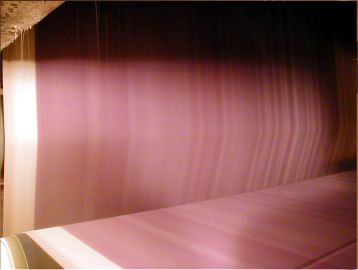Doctor and press fabric streaking cause scuff marking, case study
Oct 18, 2016
A paper machine with a tri-nip press was having sheet quality problems with scuff marking after a normal machine outage. The scuff marks could be seen at the reel as the jumbo roll was building and especially after coating the base paper. The scuffs were located across the entire machine in 1-10 inch discrete bands. One of the machine operators noticed that there were white bands on the center roll that appeared to be similar in spacing. This was not normal.
A CD paper sample was marked with the scuff marking zones and compared to the center roll buildups and found to be a close match. With the machine down, the white buildup was found to be a filler material.
Problem #1 – DST tube size
Two contributing factors combined to create this quality problem. First, the filler streaking on the center roll would not be a problem if the center roll doctor was working properly. It was found that the setup of the doctor beam was wrong. A larger double soft tube (DST) loading tube was installed on the load side of the DST on the machine outage. The unload side tube size was not changed.
In order to properly set up a DST doctor blade, you first equalize the pressure on both tubes, and then set up the blade beam angle to the roll. Since the load size of the DST was larger, the blade was in a pre-loaded position when the beam angle setup was performed. When loaded against the center roll with this larger load tube, there was visibly more bend to the blade than normal. Because of the sharp bend in the doctor blade, the blade was not riding on the sharp tip and therefore not doing an adequate job of cleaning the center roll. The larger load tube was replaced with the standard load tube and then the doctor beam was reset to the proper angle.

Felt streaks
Problem #2 - Severe streaks on bottom press wet felt
A second contributing factor for the filler buildup on the center roll in the first place was a severely streaky bottom press wet felt. The scuff pattern and the center roll filler bands matched the streaks on the bottom felt perfectly as well. It was found that the light colored bands on the inside of the felt corresponded with dark bands on the outside of the felt and vice versa.
The chemical cleaning system on this felt run was located on the inside of the felt run just before the uhle box. In order to clean the sheet side of the felt, a uhle box must suck the chemical through the felt. Where the felt appeared to be "clean" (white) on the inside, the felt was actually plugged (i.e. no purple dyed water flows through the felt in the 1st press nip). Where the felt was purple on the inside the felt was open (i.e. free purple water flows through the felt in the press nip). The center roll buildups lined up with the plugged portions of the bottom wet felt.
Apparently, where this bottom felt was plugged, more loosely bonded filler stayed on the sheet surface before contacting the center roll in the second nip. After the bottom wet felt was changed and doctor blade reset, no more scuff marks were reported.
This example shows the importance of properly setting up center roll doctor blades (~27°) and having a good wet felt cleaning program. All low pressure fanning showers need to be working and overlapping. Visible streakiness on either side of the felts should not be seen.
For more information on doctor setup, felt troubleshooting and improving press section runnability, contact your Valmet representative.